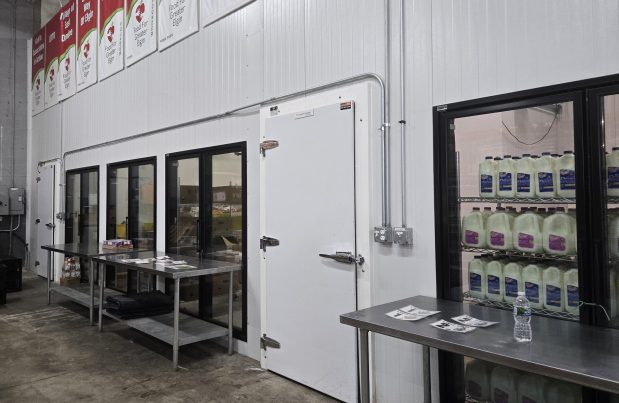Food for Greater Elgin celebrated Friday the $1 million expansion of its food pantry warehouse, which has added more storage space, a large walk-in cooler and freezer, and a satellite office for Centro de Informacion.
With the addition, the nonprofit agency was able to create larger shopping aisles for guests and improve efficiency by making it easier for patrons to shop and products to be stocked, Executive Director Andres Diez said at a ribbon-cutting.
The 14,000 square feet of new space triples the size of the building at 1553 Commerce Drive in Elgin so they can now accept more food donations, according to senior distribution coordinator Christian Sandoval.
“We’re able to take in a lot more food. It gives us a bigger reach,” he said. “What I love is the fact that the new carts and the way we redesigned the warehouse (make) it easier to get people (through the distribution process.)”
The Elgin-based pantry is the largest in Kane County and in the Northern Illinois Food Bank’s 13-county service area, said Emily Tyler, director of development. It “re-harvests” food from grocery stores and store warehouses, which minimizes food waste, she said.
Food for Greater Elgin opened in 2011 and served 138,700 people in its 2023-24 fiscal year, which ended in June. That number includes about 1,500 people who have food delivered because they can’t physically come to the pantry, Tyler said.
“(The last fiscal year) began with a continued increase year to year, but it really tapered off in the last six months. We had a 13% decrease,” said Diez, who started with the organization as a volunteer and became executive director a year ago with the retirement of Michael Montgomery.
That decline is good news, Diez said. There had been a steady increase in food demand over the last few years especially as the number of asylum seekers entering the U.S. climbed. “We saw that beginning to decrease about four months ago,” he said.
That said, there are still a lot of people in need. Projections indicate the pantry will serve about 160,000 guests in its new fiscal year, Diez said.
Broken down, about 30% of those served are children, 21% are ages 25 to 35, 20% are 26 to 50, and 10% are over 60, he said. According to the data, 75% are Hispanic and many are people with one or more jobs but still have trouble time making ends meet, he said.

The agency recently conducted a survey to learn more about its guests. It found that in the last fiscal year, 57% of households were new every 12 months, 36% visited only once in 2024 and 15% visited at least once a month.
About 85% said they appreciate being able to choose their own food rather than having the choices made for them, 70% said staff and volunteers make them feel welcome, and 54% believed the selection process worked well.
Another survey will be done in the fall to find out what kinds of services guests need and would like to see at the pantry.
Diez and Tyler said a strategic goal is to create a hub in which they can provide many social services guests need at the pantry so it can serve as a one-stop loction. The survey will help determine which organizations the pantry should seek to partner with, Tyler said.
Gloria Casas is a freelance reporter for The Courier-News.





